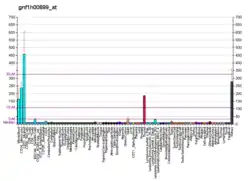AGPAT9
Glycerol-3-phosphate acyltransferase 3 (GPAT-3) is an enzyme that in humans is encoded by the AGPAT9 gene.[5][6][7][8] GPAT-3 is also known as:
- 1-acylglycerol-3-phosphate O-acyltransferase 9 (AGPAT9),
- lysophosphatidic acid acyltransferase theta (LPAAT-theta), or
- lung cancer metastasis-associated protein 1.
Function
Glycerol-3-phosphate (G3P) acyltransferases (GPAT; EC 2.3.1.15), such as GPAM and GPAT3 (this enzyme), catalyze the initial step of de novo triacylglycerol (TAG) synthesis by converting glycerol-3-phosphate (G3P) to lysophosphatidic acid (LPA).[6]
References
- GRCh38: Ensembl release 89: ENSG00000138678 - Ensembl, May 2017
- GRCm38: Ensembl release 89: ENSMUSG00000029314 - Ensembl, May 2017
- "Human PubMed Reference:". National Center for Biotechnology Information, U.S. National Library of Medicine.
- "Mouse PubMed Reference:". National Center for Biotechnology Information, U.S. National Library of Medicine.
- Clark HF, Gurney AL, Abaya E, et al. (October 2003). "The secreted protein discovery initiative (SPDI), a large-scale effort to identify novel human secreted and transmembrane proteins: a bioinformatics assessment". Genome Res. 13 (10): 2265–70. doi:10.1101/gr.1293003. PMC 403697. PMID 12975309.
- Cao J, Li JL, Li D, Tobin JF, Gimeno RE (December 2006). "Molecular identification of microsomal acyl-CoA:glycerol-3-phosphate acyltransferase, a key enzyme in de novo triacylglycerol synthesis". Proc. Natl. Acad. Sci. U.S.A. 103 (52): 19695–700. doi:10.1073/pnas.0609140103. PMC 1702318. PMID 17170135.
- Tang W, Yuan J, Chen X, Gu X, Luo K, Li J, Wan B, Wang Y, Yu L (September 2006). "Identification of a novel human lysophosphatidic acid acyltransferase, LPAAT-theta, which activates mTOR pathway". J. Biochem. Mol. Biol. 39 (5): 626–35. doi:10.5483/BMBRep.2006.39.5.626. PMID 17002884.
- "Entrez Gene: AGPAT9: 1-acylglycerol-3-phosphate O-acyltransferase 9".
External links
- Human GPAT3 genome location and GPAT3 gene details page in the UCSC Genome Browser.
Further reading
- Tang W, Yuan J, Chen X, et al. (2006). "Identification of a novel human lysophosphatidic acid acyltransferase, LPAAT-theta, which activates mTOR pathway". J. Biochem. Mol. Biol. 39 (5): 626–35. doi:10.5483/BMBRep.2006.39.5.626. PMID 17002884.
- Yamada S, Ohira M, Horie H, et al. (2004). "Expression profiling and differential screening between hepatoblastomas and the corresponding normal livers: identification of high expression of the PLK1 oncogene as a poor-prognostic indicator of hepatoblastomas". Oncogene. 23 (35): 5901–11. doi:10.1038/sj.onc.1207782. PMID 15221005.
- Ota T, Suzuki Y, Nishikawa T, et al. (2004). "Complete sequencing and characterization of 21,243 full-length human cDNAs". Nat. Genet. 36 (1): 40–5. doi:10.1038/ng1285. PMID 14702039.
- Strausberg RL, Feingold EA, Grouse LH, et al. (2003). "Generation and initial analysis of more than 15,000 full-length human and mouse cDNA sequences". Proc. Natl. Acad. Sci. U.S.A. 99 (26): 16899–903. doi:10.1073/pnas.242603899. PMC 139241. PMID 12477932.
- Suzuki Y, Yoshitomo-Nakagawa K, Maruyama K, et al. (1997). "Construction and characterization of a full length-enriched and a 5'-end-enriched cDNA library". Gene. 200 (1–2): 149–56. doi:10.1016/S0378-1119(97)00411-3. PMID 9373149.
- Maruyama K, Sugano S (1994). "Oligo-capping: a simple method to replace the cap structure of eukaryotic mRNAs with oligoribonucleotides". Gene. 138 (1–2): 171–4. doi:10.1016/0378-1119(94)90802-8. PMID 8125298.
This article incorporates text from the United States National Library of Medicine, which is in the public domain.
This article is issued from Wikipedia. The text is licensed under Creative Commons - Attribution - Sharealike. Additional terms may apply for the media files.





